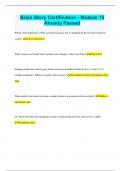Case uitwerking
Task 5. Thought suppression & Obsessive compulsive disorder
GGZ2024. Anxiety and Related Disorders. Taak 5 uitgewerkt: Thought suppression & Obsessive compulsive disorder. De aantekeningen van de tutorial zijn toegevoegd in het groen. Voor alle taken, zie de bundel
[Meer zien]













